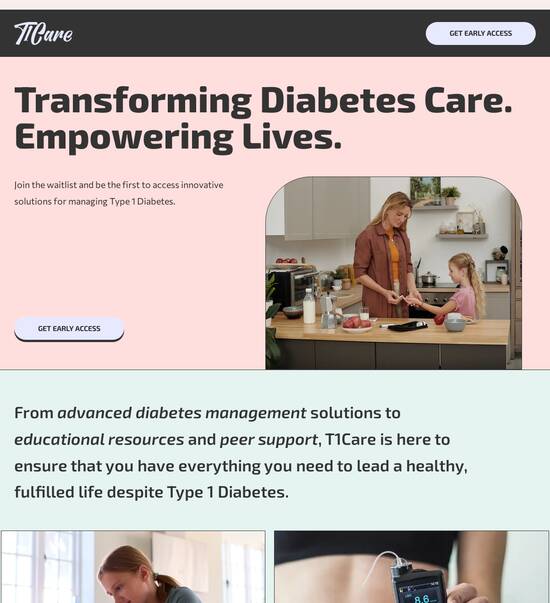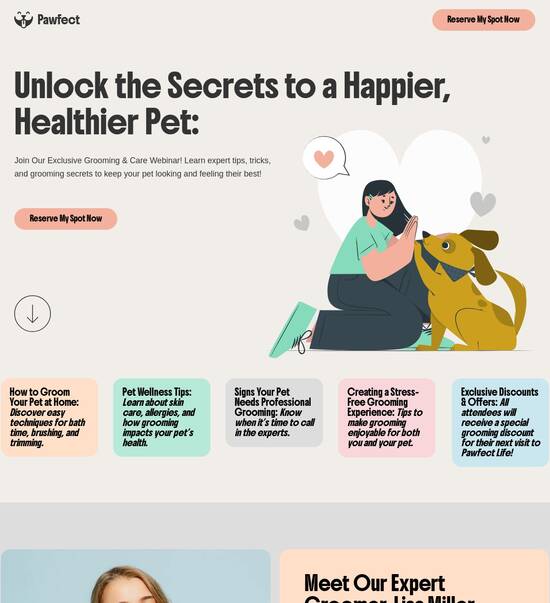
Neumorphic web page templates
Use TemplateAbout template
Master the art of web design with neumorphic web page templates. Transform your business today!
Recommended templates

Easy to build without coding
With the intuitive drag-and-drop builder, anyone on your team can create high-converting pages without any knowledge of code or design. Make enhancements to your landing page with custom widgets using Javascript, HTML/CSS, or third-party scripts.

Multiple layouts for any industry and goal
Select from 500+ landing page layouts built to boost conversions across industry-specific scenarios. Customize them by adjusting fonts, adding images, and generating on-brand content with the AI assistant. Quickly scale with Instablocks® and Global Blocks that you can save, reuse, and update globally.

Loads fast and looks polished on any device
Every template is responsive, which means they present professionally on any device and load blazingly fast with our Thor Render Engine. You can also power them up with Google AMP technology to deliver an unparalleled mobile experience and drive higher conversions.

Robust analytics & experimentation
Get real-time updates and reporting across all your devices, showing the number of visitors, conversions, cost-per-visitor, and cost-per-lead. Launch AI-powered experiments, run A/B tests, and use heatmaps to analyze user behavior, then optimize your landing page to maximize conversions.







Easy to build without coding
With the intuitive drag-and-drop builder, anyone on your team can create high-converting pages without any knowledge of code or design. Make enhancements to your landing page with custom widgets using Javascript, HTML/CSS, or third-party scripts.
Multiple layouts for any industry and goal
Select from 500+ landing page layouts built to boost conversions across industry-specific scenarios. Customize them by adjusting fonts, adding images, and generating on-brand content with the AI assistant. Quickly scale with Instablocks® and Global Blocks that you can save, reuse, and update globally.
Loads fast and looks polished on any device
Every template is responsive, which means they present professionally on any device and load blazingly fast with our Thor Render Engine.
Robust analytics & experimentation
Get real-time updates and reporting across all your devices, showing the number of visitors, conversions, cost-per-visitor, and cost-per-lead. Launch AI-powered experiments, run A/B tests, and use heatmaps to analyze user behavior, then optimize your landing page to maximize conversions.
All the features you need to build neumorphic website
Explore more featuresLearn how to build neumorphic website examples
Frequently asked questions about neumorphism landing page
Leading the way in building high-performing landing pages





Neumorphism website templates free: Your ultimate how-to guide
Instapage empowers marketers to create landing pages that enhance their conversion rates using cutting-edge techniques. With over 100 customizable templates tailored for various industries, marketers can swiftly develop engaging pages that efficiently capture leads and drive results. This guide will walk you through the essential steps to launch successful campaigns on Instapage.
Getting started with Instapage
Before diving into creating landing pages, familiarize yourself with Instapage’s platform. Sign up and explore the user-friendly interface that requires no coding skills. Begin by selecting a template suited to your campaign goals, whether it's for business services, tech/SaaS, or financial services, ensuring that the design resonates with your specific audience in the USA.
- Choose the right template: Select a template that aligns with your brand identity and campaign goals, focusing on seasonal or trending designs relevant to your target market.
- Utilize lead generation features: Use pre-built lead generation elements available in the templates to increase your chances of capturing visitor information.
- Experiment with layouts: Instapage provides various conversion-focused layouts. Don’t hesitate to test which design drives the most engagement for your landing page.
Optimizing your landing pages
Once your landing page is live, optimization is key. Instapage has built-in tools to facilitate A/B testing, allowing you to experiment with different elements such as CTAs, images, and text to see what converts best.
- Perform A/B testing: Create multiple versions of your landing page and analyze which performs better based on conversion rates.
- Use heatmaps: Leverage Instapage's detailed heatmaps to examine user behavior on your landing pages, identifying which areas visitors interact with most.
- Track analytics: Monitor your page's performance through the analytics dashboard to gain insights on visitor engagement metrics.
Personalizing the user experience
To maximize your landing page’s effectiveness, personalizing content is vital. Instapage allows you to dynamically alter text and ads based on your audience segments, ensuring your message resonates with each specific group.
- Dynamic text replacement: Automatically adjust your landing page copy based on user data to enhance relevance and appeal.
- AdMaps integration: Align your advertising campaigns with the specific landing pages to ensure a seamless experience for visitors.
- Audience tracking: Monitor performance metrics at the audience level to refine your targeting strategies further.
By leveraging Instapage's advanced features, marketers can create tailored experiences that drive conversions effectively.
In conclusion, implementing these strategies within Instapage can significantly boost your digital marketing efforts and ROI.
Ready to get started? Sign up for Instapage today and harness the power of optimized landing pages to enhance your marketing campaigns.
People also ask about Neumorphic web page template
Understanding neumorphic web page templates
Understanding neumorphism: A new paradigm in web design
Neumorphism is a design approach that blends elements of skeuomorphism and flat design, creating a soft and subtle user interface (UI) experience. This style is often referred to as 'soft UI' because it emphasizes the use of soft shadows, highlights, and a very gentle tactile feel. Unlike traditional flat designs that rely on stark contrasts and rigid lines, neumorphism introduces a more organic and inviting aesthetic that seeks to simulate physicality through shadows and light.
Historically, UI design has seen significant shifts, moving from hyper-realistic textures and objects that defined skeuomorphism to the minimalist approaches of flat design. The advent of neumorphism marks an interesting return to a more tactile interface, yet it remains firmly planted in contemporary design principles. As users grew accustomed to flat interfaces, designers needed a new way to innovate while retaining familiarity. Neumorphism fills this gap, facilitating a design that is both nostalgic and refreshingly modern.
The aesthetic appeal of neumorphism
Neumorphic design is characterized by several core traits that set it apart from other design styles. Most notably, the use of soft shadows and highlights plays a crucial role in creating an illusion of depth. Elements appear to gently emerge from the background, which can evoke a sense of physicality and tangibility. This effect is achieved by strategically placing shadows and highlights that mimic natural light interactions. As a result, buttons and cards seem to float, inviting user interaction without the harshness sometimes felt in flat designs.
Color palette choices in neumorphism often lean towards pastels and light shades, which complement the soft design ethos. The goal is to create a pleasing visual experience that promotes comfort and accessibility. This aesthetic can significantly influence emotional responses, as users may gravitate towards a design that feels warm and inviting. Furthermore, neumorphism employs visual hierarchy effectively. Elements are designed in such a way that they guide user attention towards important features naturally, which enhances overall usability.
Exploring neumorphic components and elements
Core UI elements in neumorphism function harmoniously within this design framework. Buttons are a prime example; they take on depth through shadows that indicate interactivity. A neumorphic button typically appears as though it could be pressed, providing intuitive feedback to users. Similarly, cards—commonly used for displaying content—differ from their flat counterparts by featuring subtle elevations. This distinct layering sets them apart, making them visually appealing while also functional.
Input fields, another essential component, are designed to engage users seamlessly. Neumorphic input fields display shadows that suggest depth, making them look like they can be interacted with. Beyond the basic elements, advanced UI kits offer comprehensive libraries for designers looking to adopt neumorphism. There are several popular UI kit websites where one can find well-designed neumorphic elements. These kits often come with various customization options, allowing brands to maintain visual identity while utilizing cutting-edge design techniques.
Developing a neumorphic web page template
Creating a successful neumorphic layout involves several components that align with the overall design philosophy. A key aspect of this is implementing grid systems that facilitate the arrangement of soft elements. Effective layering techniques are also crucial, enhancing depth perception to create a convincing 3D-like experience on flat screens. These foundational elements work together to form a cohesive and interactive web experience.
Choosing the right color schemes that support soft aesthetics.
Incorporating light and shadow effectively for depth.
Ensuring responsive design across devices to accommodate all users.
Utilizing CSS and HTML best practices for optimized performance.
By following these steps, designers can craft templates that resonate with users while remaining uniquely effective for any marketing objective.
Benefits of neumorphism for users and designers
Neumorphism offers enhanced user engagement through intuitive designs. The softness and layered look of this design style facilitate easier navigation, making interfaces user-friendly while encouraging interaction. Actionable elements, such as buttons and links, are more visible within a neumorphic framework, which may lead to increased interaction rates. This improved usability is essential for any effective landing page, especially within sectors such as marketing, technology, and e-commerce.
Additionally, web designers must consider browser compatibility and performance issues that could arise with neumorphic designs. Cross-browser testing is essential to ensure a uniform experience across all platforms. Performance optimization techniques, such as minimizing heavy design elements and ensuring fast load times, should also be prioritized. By implementing these strategies, designers can leverage the benefits of neumorphism while mitigating potential user experience challenges.
Practical applications of neumorphic design in web page templates
Neumorphism finds practical applications across a variety of industries. For example, in e-commerce, it can elevate product displays and interactions, making items appear more inviting while enhancing usability. Similarly, Software as a Service (SaaS) platforms benefit from simplified complex interfaces through neumorphic designs. By presenting information clearly and attractively, users can navigate systems with ease, ultimately leading to better user satisfaction and retention.
Adapting neumorphism effectively for different versions of websites—such as desktop vs. mobile—requires focused design strategies. While mobile design often prioritizes simplicity and minimalism, desktop designs can explore more intricate neumorphic features due to larger screen real estate. Additionally, it’s vital to adhere to accessibility standards, ensuring that all users, regardless of ability, can interact with and benefit from the design.
The role of neumorphism in improving conversion rates
Incorporating neumorphic design can significantly influence user behavior on web pages, which can lead to improved conversion rates. Analyzing user behavior within neumorphic interfaces is crucial, and tools such as heatmaps can provide insight into where users focus their attention. By collecting data for optimization, designers can refine their approaches to create even more engaging landing pages.
A/B testing also plays a pivotal role in comparing neumorphic designs with traditional flat designs. This process reveals how variations impact user interaction. To harness the power of neumorphism effectively on landing pages, clear calls to action are essential. Users should understand what is expected of them when they encounter a neumorphic element, and crafting engaging copy in tandem with these designs can enhance overall effectiveness.
Future trends and innovations in neumorphism
The evolution of neumorphism suggests that there’s considerable potential for future advancements in design. As technology continues to evolve, integrating AI and interactivity within neumorphic frameworks may become standard practice. This integration can allow for personalized user experiences within this visually appealing context, tailoring interactions to user behaviors and preferences.
Moreover, combining neumorphism with other emerging styles could lead to innovations that enhance the user experience further. It’s essential for the design community to share insights, emphasizing challenges and best practices encountered during implementation. Open-source resources offer collaboration opportunities, enabling designers and developers to explore neumorphism's full potential together.
Conclusion: Embracing neumorphism in digital design
Neumorphism represents a compelling intersection of creativity and functionality in digital design. Its nuanced aesthetics have the power to enhance user experience significantly while retaining a minimalist touch. Key takeaways from this exploration highlight neumorphism's capacity to improve engagement, facilitate better navigation, and adapt across various platforms and devices.
As designers continue to innovate and adapt to changing user needs, incorporating neumorphism could be a forward-thinking approach. The future of design is not just about visual appeal; it’s about creating experiences that encourage trust, loyalty, and ultimately, conversions. Following these insights, businesses can align their design strategies with market expectations and user desires, reflecting the vibrant field of modern web design.
Ready to skyrocket conversions?
Supercharge your ad campaigns with high-performing landing pages
Get started














